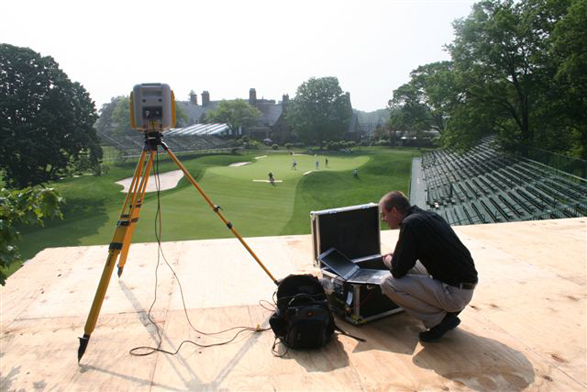On June 15 the world’s best golfers tee off at the 106th U.S. Open at the Winged Foot Golf Club in Mamaroneck, NY. Week before last, Trimble‘s Mark Klusza and Ken Slaugenhoupt surveyed the 18th green of Winged Foot with a GX300 scanner and an R8 GNSS RTK system to produce a DTM (digital terrain model). According to Klusza, the DTM gives detailed insight into how the hole breaks. Today The New York Times features the scan data in a story on page 12 analyzing just that – areas of slope on the green, direction of slopes, and how putts from various locations will break.
Okay, but does 3D laser scanning really have a use on the golf course?
We think so. Many golf courses around the country, even some of the most august, appear to have very limited dimensional information about their as-found (existing) topography. Worse, many seem to have scant documentation of the architect’s original course design. This matters because course conditions change with time. Routine maintenance can compromise the all-important contours of greens; natural subsidence of the earth can take a toll as well. Rarely if ever is this documented.
Digital capture of a course’s topography offers several benefits. First it provides a needed archive of the course. The digital record then enables automated cut-and-fill operations for both new construction and remediation.
We first wrote about laser scanning for golf course replication two years ago – the case was the island green at TPC Sawgrass. (Coincidentally, Scott W. Pool of GreenScan, the golf course architect and laser scanning service provider who executed that project, also helped provide the analysis of the 18th green at Winged Foot in today’s New York Times, together with Mark Sweeney of TPSGolf.) Now, with the tools getting more surveyor-friendly, this approach will become increasingly attractive to both architects and constructors of golf courses. We believe architects will embrace 3D laser scanning enthusiastically because it enables higher-fidelity realization of their designs. For course owners, it’s a tool to preserve and maintain courses in their original, often treasured designs.
Golfers are enthusiastic, some say fanatical, about embracing new technology – composite graphite shafts, multilayer balls, on and on. GPS technology has made it big time – you can see distance to the pin displayed on your golf cart today. Perhaps 3D laser scanning is next. Figuring out how to play a tough lie – DTM on a PDA, anyone?






